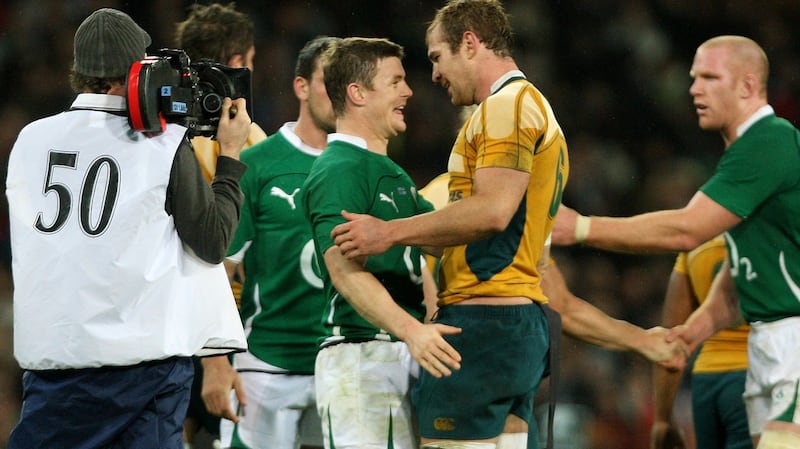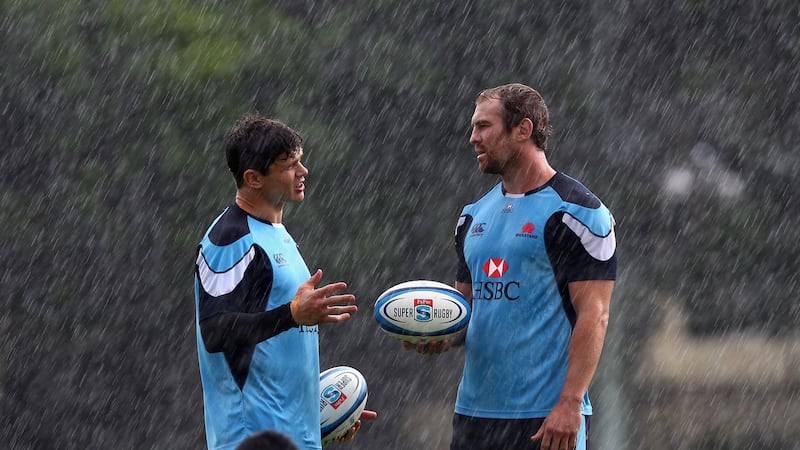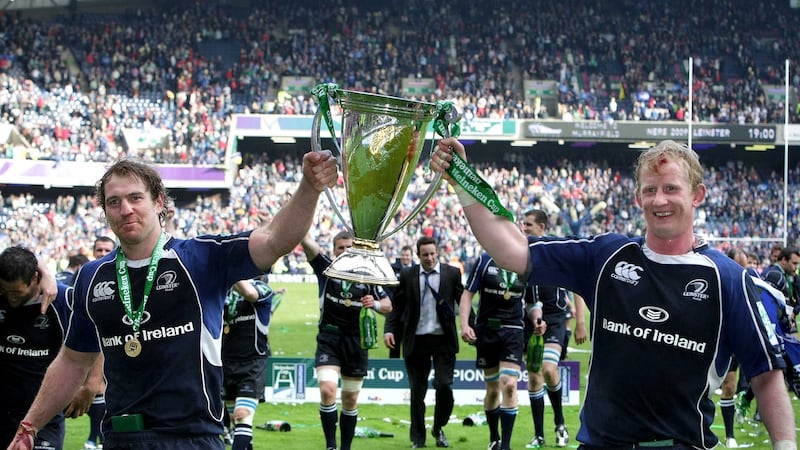Rocky Elsom’s biographer wastes no time entering the realm of hagiography.
"Rocky is like a modern day renaissance man, a Leonardo da Vinci in studs," wrote Bret Harris in 2011. "Apart from being one of the greatest Wallabies of his generation, Rocky is a musician, a philosopher, an entrepreneur and a pilot just to list a few of his pastimes."
That's only the blurb. By the time Harris interviews Elsom's family in chapter one this "mythical hero" is framed as two Clint Eastwood characters, Dirty Harry and the strong silent cowboy. He's also a "Viking warrior" yet "quintessential Australian" seemingly in the mould of Ned Kelly.
Portrayed as "the embodiment of the human spirit" (this may sound far-fetched - because it is) such hyperbole would have been gobbled whole by newly minted Leinster fans after Elsom burst the Munster damn in Croke Park before trampling over Leicester's Alesana Tuilagi in the Heineken Cup final at Murrayfield.
Both feats happened in May 2009 at the end of his never to be forgotten solitary season in Dublin.
But what on earth did Rocky do next?
Plenty.
The ink was barely dry on "Rocky Elsom - leader of the Wallabies" when Australia coach Robbie Deans replaced him as captain on the eve of the 2011 World Cup.
“It was a necessity,” Deans tells The Irish Times. “Anyone who has been to a World Cup knows how all encompassing they are and Rocky really had his hands full just getting there. I didn’t want him having to deal with the peripheral demands of captaincy. Just wanted him to get into the pivotal state to play because he was limping from game to game at that point.”

The gig was passed to James Horwill. Turns out his brief Irish sojourn was the last peak Elsom the rugby player ever scaled. Australia under Deans experienced a tumultuous tournament in New Zealand, losing to Ireland in the pool stages before recovering, in typical Wallabies fashion, to topple the Springboks in the quarter-final. Elsom's body held up to be a constant at number six but nobody could live with Richie McCaw's signature performance in the semi-final. Not even the man who had dominated European rugby 18 months earlier.
At just 28, Elsom would never wear the green and gold again.
“He was still in his prime but he picked up an injury that ultimately took its toll,” explains Deans. “The frustrating thing was Australia could have seen a lot more of him if he had been able to master his physical state.
“But what he did do was not insignificant. He led the team to their first Tri Nations in a decade (2011), he led them to the first win on the High Veldt for 47 years and to second in the world. So he did some good stuff in the jersey.”
The splendid isolation of Elsom in 2009 will never be forgotten but there is way more to this mysterious man.
He didn't need the acceptance of everyone to stand tall himself
“Nobody knows Rock,” said one veteran Australian journalist.
Former Ulster and Ireland coach Les Kiss is quoted in Elsom's biography as comparing him to the complex character Howard Roark in Ayn Rand's novel The Fountainhead. Basically, Elsom/Roark captures the "spirit of individualism." Roark is eventually arrested for dynamiting a building he designed because others tried to dilute his vision.
“He was a man who just knew himself and understood himself,” Kiss explains. “He was comfortable with himself, totally. He didn’t need the acceptance of everyone to stand tall himself.”
“Enigmatic” is the shared word from former Leinster teammates.
“He was a decent enough guy but none of us really got to know him,” wrote Gordon D’Arcy. “Sport is primarily about bonding on the pitch and Rocky optimised this when he played, and the odd time he trained. Cheika knew how to get the best out of the player and the person, leaving him to his own devices when it came to conditioning and preparation.
“Perhaps the biggest impact by any foreign player ever on Irish rugby belongs to Rocky Elsom,” D’Arcy continued. “Not the most valuable, that’s Isa, or sustained, Isa again, but impact-wise what Rocky did stands the test of 10 years.
"The best blindside in the world came to do a specific job. He earned his hefty salary but no team wants more than one, maybe two players like him in the squad as it can disrupt the culture. There should be exceptions for a Rocky Elsom but in the same breath Nacewa, Brad Thorn and Scott Fardy perform similar heroic feats while also raising standards off the pitch."

Deans chuckles at each vague description before explaining their coach-player relationship.
“Rocky cared deeply about the challenge. He had an understanding of the importance of the role and the responsibility that he had (as Wallaby captain). He didn’t use a lot of words but he was a good communicator one-on-one. He thinks a lot deeper than people who have not been exposed to him would realise. He certainly thinks a lot more than he says.
“He’s very comfortable in his own skin,” says the former All Black. “He didn’t feel the need to create a perception. He just went about his work. He wasn’t concerned how people perceived him. He was more concerned with outcomes.”
Elsom’s playing days ended in France. Not Toulon, where he played justtwo games in 2013, but Narbonne on the Mediterranean coast.
Here's where the story takes a strange turn. Leading a consortium of Australian investors, including World Cup winning coach Bob Dwyer, Elsom took over RC Narbonne in an attempt to create rugby's version of "Moneyball."
That’s how initial reports painted a situation that descended into accusations of financial mismanagement and police investigation.
“I wasn’t the most popular guy in town at that time but I would have been less popular in the long run had those measures not been taken,” said Elsom in 2014 after severe cost cutting and foreign recruitment looked to be guiding this deep rooted rugby community back towards the Top 14.
It was Rocky Elsom, in a black rage, who had forced past my secretary
But, overall, the Narbonne venture (2013-16) failed spectacularly with the team relegated to semi-professional status in Federale 1.
In June 2016 Frédéric Pinet, former lawyer to the club, lodged a police complaint claiming he was threatened by Elsom.
"I was with a business associate in my office on the first floor when I heard someone screaming my name and climbing the stairs, stamping their feet," Pinet told French media. "It was Rocky Elsom, in a black rage, who had forced past my secretary. He was accompanied by (Tongan player) Lei Tomiki, who stayed at the door. Once in my office, Elsom looked at me, face to face and yelled, 'My cheque! My cheque!' I thought he was going to hit me."
Elsom denied threatening Pinet.
Jérôme Prevot, writing for Midi Olympique in April 2018, stated: “We had never seen such a secretive president. His media revelations were as rare as those of the Queen of England. He seemed to particularly enjoy isolating the city club from its supporters, elected officials, partners and all the media. He appeared at the last moment just before the matches, pretending not to speak French.
“All this ended in June 2016 with a debt of €750,000 and an administrative demotion by the DNACG (colloquially known as the ‘financial police’) . . . Elsom quickly disappeared, without any formal announcement, for new mysterious adventures. Who can know what he is doing right now? He has not reappeared in Narbonne.”
In 2017 Elsom did briefly reappear in Australian public life fronting a consortium that sought to take over the Melbourne Rebels.
Epilogue - reunion
Ten years after being so instrumental in Leinster winning their first European title he is expected in Dublin for the reunion tomorrow night.
“We adopted an under-12s mentality in many games that season,” said D’Arcy. “Give the ball to the big fella and pile after him.”
“13 man of the matches,” Mal O’Kelly remembered during Off The Ball’s recent tribute to the ‘09 team.
"Cheika's special friend," went Shane Jennings nodding towards his former coach. "The two of them were tight. Just like Joe and Johnny in the successful years that followed."
Jennings and Cheika then tell the car crash yarn or “little fender bender” in Donnybrook.

“Rocky had the car accident and everyone was looking for him,” laughed Cheika. “Where is he? Has he gone to hospital? No one could find him. He was back in the gym lifting weights. He just left the car in the middle of the road. Nah, guy is a genius. Genius.”
Genius or not the flanker was precisely what Leinster needed until Seán O’Brien came of age.
“Rocky was not easy to rattle,” Deans adds. “He’d do the rattling.”
That’s what made him such a valuable asset on the field.
Off the field Elsom utterances remain rare jewels. “I work hard on my habits to affect how I act,” he said in the biography’s foreword. “I have a strong idea of what is right, the person I want to be, and being that is my first priority. I also believe that if I am fully and truly immersed, then that is the best way for me to affect the group. I think that is very powerful in many senses - whether it’s popular or not I’d say I have to act in a way that is true to what I believe and become what I idolise. And that is also my biggest struggle.”
The book does shine light on his name, which is not after the Sly Stallone film but The Beatles ballad from The White Album where 'Rocky Raccoon' tracks down the 'other guy' his woman ran off with only for 'Danny Boy' to prove quicker on the draw.
That's his full name: Rocky Dan Elsom.




















